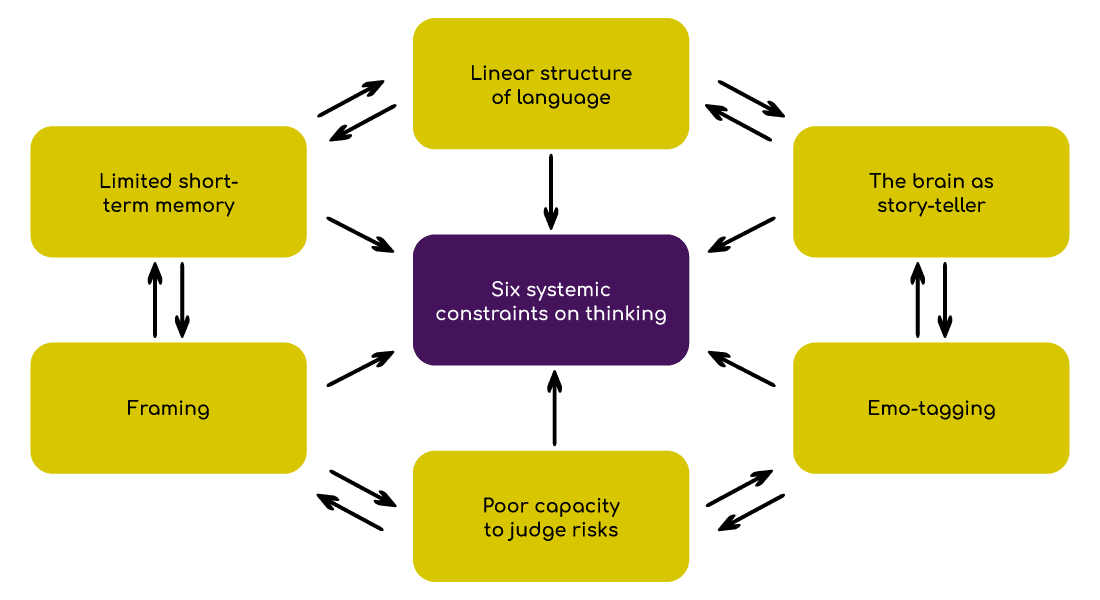The process of decision-making in the corporate world can be a complex and challenging endeavor. It requires an understanding of the various factors that influence decision-making, as well as the tools and techniques that can be used to help facilitate the process.
There are different knowledge models that help to define the structure of the decision problem and the relationships between different elements. Some knowledge models can be then used to develop scenarios based on different assumptions and hypotheses, and that highlight the interrelations between the various elements or constraints, and their impact on each other in the different scenarios.
What is decision-making about?
Decision-making is an essential cognitive process that allows individuals to choose between different options and courses of action. In complex environments, decision-making can become more challenging, as the number of variables and factors that need to be considered increases.
The science behind decision-making in times of complexity is multidisciplinary, drawing from fields such as psychology, neuroscience, behavioral economics, and sociology. Researchers in these fields have identified a range of factors that can influence decision-making in complex situations, including cognitive biases, limits in thinking, emotional states, and social context.
The challenges and biases in problem-solving and decision-making
One of the key challenges when solving problems and making decisions in times of complexity is dealing with uncertainty. Uncertainty refers to the lack of information or knowledge about the potential outcomes of different courses of action. In complex situations, uncertainty can be especially high, as there may be many variables, factors and constraints that are difficult to predict or control.
To deal with uncertainty, decision-makers often rely on heuristics, or mental shortcuts, that allow them to solve problems quickly and simplify the decision-making process. Heuristics can be useful in many situations as they allow us to find solutions with reduced mental effort, but they can also be detrimental to problem-solving and the quality of our decisions, as the outcome of these mental shortcuts might be influenced by some cognitive biases, which are systematic errors in our thinking process. This often results in poor decision-making.
For example, if we take the so-called “availability heuristic”, which is a cognitive bias in which individuals rely on the most easily available information when making decisions, we see that in times of complexity, this can lead to over-emphasizing certain factors or variables that will be more salient or memorable, while neglecting others even though they may be equally or more important.
Emotional states can also influence our decision-making in times of complexity. In fact, research has shown that emotional arousal can lead to increased risk-taking behaviour, as well as a reduced ability to think clearly and make rational decisions. Of course, in complex situations, emotional states can be especially intense, as decision-makers may feel pressure or stress to make the right choice, which in turn increases the risk of poor decision-making.
Social context can also play an important role in our decision-making in times of complexity. For instance, social influence, or the impact that other people have on an individual’s decision-making, but also the desire to conform to certain social expectations, can be especially strong in complex situations and lead to biased solutions and decisions.
How to reduce the influence of these factors on the problem-solving and decision-making process
Systems thinking, a holistic approach that focuses on a system as a whole and on how the different elements that constitute it are interrelated and linked to the context, offers a powerful methodology to deal with complexity and greatly helps to prevent biases.
Some models used in decision-making design, inspired by systems-thinking, provide a structured approach to making decisions that involves evaluating options based on the goals, the constraints or limitations, the relevant stakeholders and a set of criteria. This can be very helpful to create dynamic scenarios that take into account the variables and their interrelations, and thus offer evolutive maps of our systems as we make decisions in complex environments.
Dan Ariely: “Amazing Decisions: The Illustrated Guide to Improving Business Deals and Family Meals”, MacMillan, 2019
Dan Ariely: “Predictably Irrational, Revised: The Hidden Forces That Shape Our Decisions”, Harper, 2015
Britt Glatzeder, Vinod Goel, et al.: “Towards a Theory of Thinking: Building Blocks for a Conceptual Framework”, Springer, 2012
Dietrich Dörner: “Die Logik des Mißlingens. Strategisches Denken in komplexen Situationen“, Rowohlt Taschenbuch, 2003
Albrecht von Müller: „Die Selbstentfaltung der Welt: Eine Einladung, Zeit und Wirklichkeit neu zu denken und mit Komplexität anders umzugehen“, Siedler Verlag, 2020
Authors:
Gaëlle Piernikarch
Founder & CEO
gaelle@cambiana.com
Dr. Tobias Adam
CEO Parmenides AG
tobias.adam@parmenides-ag.com
Gisela Zweck
Managing Director Magnify Innovation
gisela.zweck@magnifyinnovation.com




